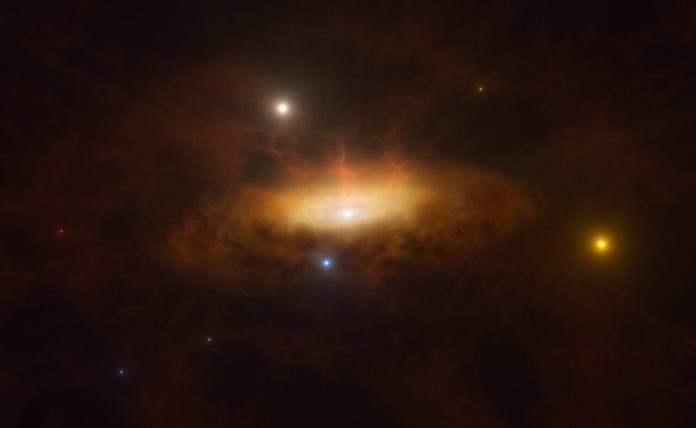
In late 2019, a galaxy known as SDSS1335+0728 suddenly started shining much brighter than ever before.
This unexpected event caught the attention of astronomers.
To find out what was happening, they used data from several space and ground-based observatories, including the Very Large Telescope (VLT) in Chile.
Today, they announced that they are witnessing something never seen before in a galaxy—the sudden awakening of a massive black hole at its core.
“Imagine you’ve been watching a distant galaxy for years, and it always seemed calm and inactive,” says Paula Sánchez Sáez, an astronomer at the European Southern Observatory (ESO) in Germany and lead author of the study published in Astronomy & Astrophysics.
“Suddenly, its core starts showing dramatic changes in brightness, unlike anything we’ve seen before.”
This is exactly what happened to SDSS1335+0728. In December 2019, the core of this galaxy brightened dramatically, and it is now classified as having an active galactic nucleus (AGN). This means a bright, compact region powered by a massive black hole.
Some events, like supernova explosions or tidal disruption events (when a star gets too close to a black hole and is torn apart), can cause galaxies to suddenly light up. However, these brightness changes usually last only a few dozen or a few hundred days. SDSS1335+0728, located 300 million light-years away in the constellation Virgo, is still getting brighter more than four years after it first lit up. This unusual and ongoing brightness is unlike anything seen before, leading astronomers to believe something different is happening.
The team studied the brightness variations using a mix of old and new data from several observatories, including the X-shooter instrument on ESO’s VLT. They compared data from before and after December 2019 and found that SDSS1335+0728 is now emitting much more light at ultraviolet, optical, and infrared wavelengths. The galaxy also started emitting X-rays in February 2024.
“This behavior is unprecedented,” says Sánchez Sáez, who is also affiliated with the Millennium Institute of Astrophysics (MAS) in Chile.
Co-author Lorena Hernández García from MAS and the University of Valparaíso in Chile adds, “The most likely explanation is that we are seeing the core of the galaxy starting to show activity. If so, this would be the first time we see the awakening of a massive black hole in real time.”
Massive black holes, with masses over 100,000 times that of our sun, exist at the center of most galaxies, including our own Milky Way. Usually, these black holes are dormant and not visible. Claudio Ricci, another co-author from the Diego Portales University in Chile, explains, “In the case of SDSS1335+0728, we observed the black hole waking up and starting to feast on gas in its surroundings, becoming very bright.”
While this process has never been observed before, it provides valuable information on how black holes grow and evolve. Follow-up observations are needed to rule out other explanations, such as an unusually slow tidal disruption event or even a new phenomenon. Regardless of the cause, this discovery gives scientists important insights into the behavior of black holes.
This research was presented in a paper titled “SDSS1335+0728: The Awakening of a ∼ 106M⊙ Black Hole,” published in Astronomy & Astrophysics.



